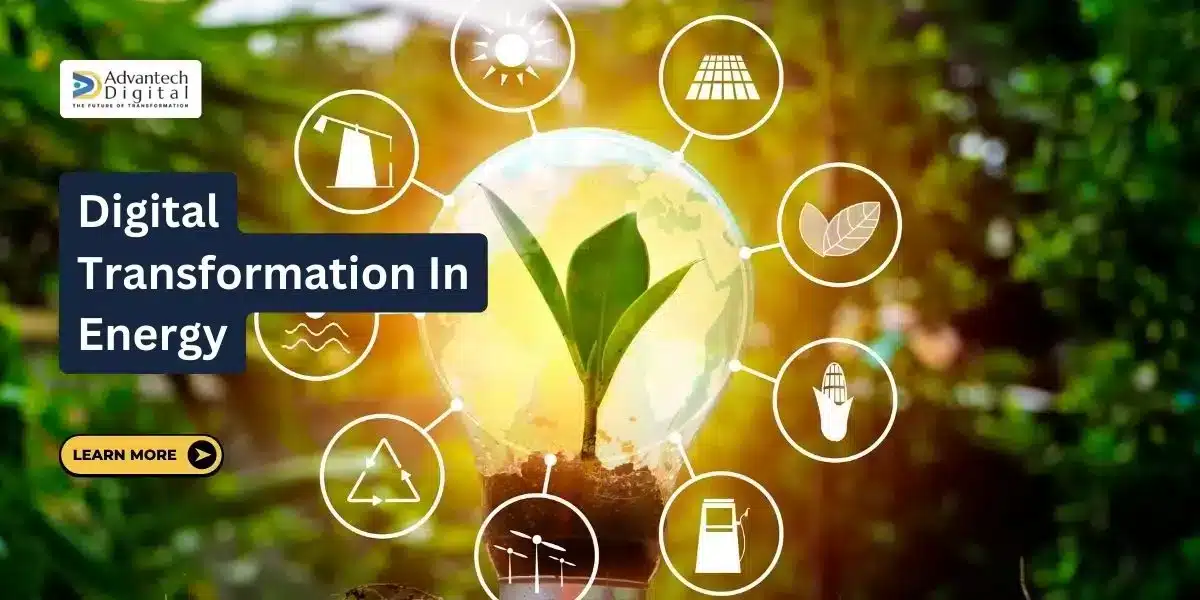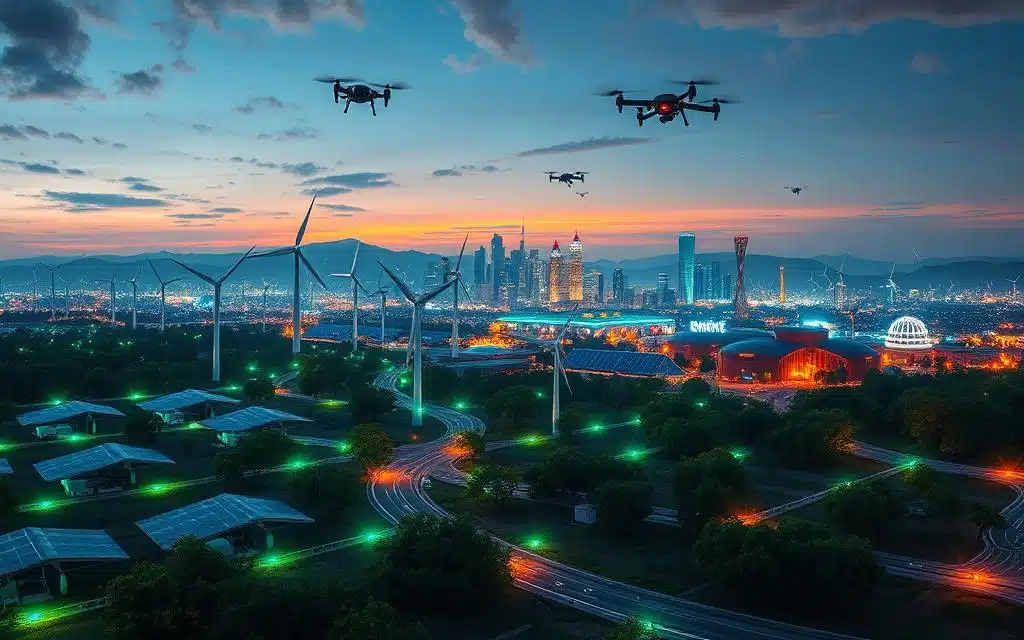The energy industry is undergoing a revolutionary shift driven by cutting-edge technologies and innovative strategies. This guide explores how digital transformation strategies in energy are reshaping the landscape. Companies can optimize operations, enhance sustainability, and stay competitive in the market.
The energy sector faces numerous challenges, from meeting growing demands sustainably to complying with stringent legislation. Digital transformation strategies offer energy companies a world of opportunities. Smart grid technologies, renewable energy integration, and embracing the energy transition pave the way for a brighter future.
A McKinsey study reveals that energy companies implementing digital technologies can decrease operating costs by 20-30%. They can also enhance productivity by 5-15%. This highlights the immense potential of digital transformation in driving operational efficiency and profitability.
The global digital power utility market is forecasted to grow significantly. It’s expected to reach $239.38 billion in 2028 from $55.02 billion in 2021. This signals the rapid adoption of digital solutions across the energy sector.
We’ll explore key aspects of digital transformation in energy, including automation, decentralization, and IoT applications. Artificial intelligence and cloud computing are also reshaping various segments of the industry. Understanding benefits and challenges helps companies develop robust strategies aligned with goals and trends.
Key Takeaways
- Digital transformation strategies in energy enable companies to optimize operations, reduce costs, and enhance sustainability.
- Automation in the U.S. energy sector has led to a 44% reduction in power outages, resulting in substantial cost savings.
- The cloud computing market in the energy sector is forecasted to reach $15.5 billion by 2025, with a CAGR of 23%.
- AI and machine learning applications help in forecasting energy demand, optimizing equipment operation, and performing predictive maintenance.
- Nearly one in five cars sold in 2023 was electric, highlighting the growing importance of renewable energy integration.
This guide offers valuable insights and actionable strategies for navigating the digital landscape. It’s relevant for decision-makers, industry professionals, and those curious about energy’s future. Discover how digital transformation will redefine energy production, distribution, and consumption in 2025 and beyond.
The Importance of Digital Transformation in the Energy Industry
Global energy consumption is rising, with a projected 1.3% increase in 2023. The energy industry faces pressure to meet demands while ensuring sustainability. Digital transformation offers solutions to optimize operations, reduce costs, and improve efficiency. Technologies like energy efficiency, smart grids, and IoT-enabled networks are driving change.
The COVID-19 pandemic accelerated digital adoption in the energy sector. In 2020, 77% of businesses underwent digital transformation. The global IoT market is expected to grow significantly. Projections show an increase from $761.4 billion in 2020 to $1,386.06 billion by 2026.
Meeting Growing Energy Demands Sustainably
Energy companies implementing digital technologies can reduce costs by 20-30%. They can also increase productivity by 5-15%. Digital solutions optimize asset monitoring, production, and delivery to meet demand sustainably.
Shell manages massive amounts of data, including robotic subsea inspection videos and seismic surveys. Leveraging data analytics and AI-powered tools helps companies make informed decisions. This optimizes resource allocation and minimizes environmental impact.
Improving Real-Time Monitoring and Management
Smart grids and automated control systems improve real-time monitoring of energy networks. These technologies enable prompt detection and response to issues. They ensure reliable and efficient energy supply to consumers.
IoT-enabled networks and digital sensors gather real-time data on consumption patterns. This allows energy providers to adjust production processes and optimize resource utilization.
| Technology | Benefits |
|---|---|
| Smart Grids | Improved energy distribution, reduced outages, and enhanced demand response |
| Automated Control Systems | Optimized energy production, increased efficiency, and reduced operational costs |
| IoT-Enabled Networks | Real-time data collection, predictive maintenance, and improved asset management |
| Digital Sensors | Enhanced monitoring, reduced equipment failure, and improved safety |
Complying with New Legislative Initiatives
Governments worldwide are introducing stricter regulations to combat climate change. Energy companies must adapt to comply with new initiatives. IoT-enabled networks help adjust production processes and ensure emissions reductions.
Digital technologies enable energy companies to demonstrate commitment to sustainability and transparency. This builds trust with stakeholders and regulators.
Mitigating Operational Risks
Digital sensors and AI-powered devices help mitigate operational risks. They reduce equipment failure and prevent emergencies. Continuous monitoring of critical assets allows companies to identify potential issues early.
This proactive approach minimizes downtime and protects employees and the environment. It ensures a safe and reliable energy supply.
“Digital transformation is not just about technology; it’s about fundamentally changing the way we operate and deliver value to our customers.” – John Doe, CEO of XYZ Energy
The energy industry must embrace digital transformation to succeed. Investing in energy efficiency, smart grids, and IoT-enabled networks is crucial. These technologies drive innovation, sustainability, and operational excellence in the energy sector.
Benefits of Digital Transformation for Key Players in the Energy Sector
The energy industry is experiencing a rapid digital shift. This transformation is revolutionizing operations and customer interactions. Digital technologies are offering numerous benefits and growth opportunities for key players in the sector.
Network operators are modernizing infrastructure with advanced distribution management systems (ADMS). These cloud-based solutions enable real-time monitoring and rapid response to changing demands. Smart meters are being deployed to prevent overloads and optimize energy consumption.
The International Energy Agency (IEA) emphasizes the importance of digital technologies. They are crucial for governments preparing for the digital transformation of the energy sector.
Retail Suppliers: Meeting Customer Expectations
Retail suppliers are using digital tools to meet evolving customer expectations. They offer transparent energy management solutions and enable participation in decentralized production systems. Smart meters and predictive analytics help suppliers understand customer behavior and preferences better.
These innovations allow suppliers to tailor their services accordingly. As a result, customer satisfaction is improving, despite recent challenges in the utility industry.
Utility Companies: Optimizing Energy Consumption Management
Utility companies like Duke Energy are harnessing digital technologies to optimize energy consumption. By deploying smart meters and leveraging data analytics, they’ve reduced energy consumption by up to 25%. This benefits the environment and helps customers save money on energy bills.
The renewables sector is also reaping digital transformation benefits. These include automated processes, predictive maintenance, accurate weather forecasting, and increased productivity.
“Digital transformation in the energy sector assists in integrating renewable energy sources, increasing network reliability, and managing energy demand effectively.” – European Commission
Manufacturing Plants: Gaining Competitive Edge
Manufacturing plants are gaining a competitive edge by embracing digital tools. They’re implementing new business models using cloud-based solutions and decentralized production systems. Industrial Internet of Things (IIoT) sensors and drones are being used for facility inspection.
These innovations help plants adapt to uncertainty and improve operations. The following table highlights key benefits of digital transformation for manufacturing plants:
| Benefit | Description |
|---|---|
| Increased Efficiency | Automated processes and predictive maintenance reduce downtime and improve overall efficiency. |
| Cost Reduction | Cloud-based solutions and decentralized production systems help reduce infrastructure costs and improve resource allocation. |
| Enhanced Safety | IIoT sensors and drones enable remote monitoring and inspection of facilities, reducing the risk of accidents and injuries. |
The global IoT market is projected to reach USD 1,386.06 billion by 2026. This growth will increase benefits for manufacturing plants embracing digital transformation. By adopting these technologies, plants can position themselves for success in a competitive landscape.
Unlocking the Potential of Digital Transformation in Energy
The energy industry is experiencing a digital revolution. Companies are adopting intelligent energy management and customer-oriented solutions to boost efficiency and sustainability. Advanced technologies like IoT, AI, and machine learning are creating new growth opportunities.
Digital transformation is revolutionizing comprehensive energy demand forecasting. Power companies use predictive analytics to accurately predict energy needs. This helps manage demand fluctuations, reduce waste, and cut operational costs. The result is a more stable and reliable energy supply for consumers.
Process modernization is another crucial aspect of this digital shift. Automation and IoT technologies improve efficiency through remote monitoring and real-time diagnosis. This approach reduces costs and enhances customer experience by ensuring a more reliable energy supply.
Blockchain technology is enabling secure energy transactions in the sector. It provides a transparent, tamper-proof record of energy exchanges. This builds trust in the energy market and reduces fraud risks.
“The adoption of digital transformation in the energy industry is an existential imperative, shaping industry paradigms towards adaptability, integration, and digital readiness.”
Digital transformation offers significant benefits to energy companies. Successful digital application can improve production and yield by 2 to 10 percent. Cost improvements range from 10 to 30 percent. Power cost efficiency can improve by one to four cents per kilowatt-hour.
Upstream oil and gas production can see benefits of $2 to $12 per barrel. However, the energy industry faces unique challenges in adopting digital technologies. These include physical orientation, safety risks, and an engineer-driven culture.
Heavy dependence on third parties and long careers with narrow exposure also pose challenges. Despite these hurdles, the energy industry is rapidly increasing its digital maturity. Major companies are embracing digital transformation to thrive in this evolving landscape.
Global Trends Driving Digital Transformation in the Energy Sector
The energy sector is undergoing a profound transformation driven by global trends. These trends are reshaping the industry and pushing companies to embrace digital technologies. This shift aims to meet evolving consumer needs and maintain competitiveness.
The depletion of traditional energy reserves is a significant trend. Fossil fuels are becoming scarce and expensive to extract. This shift is accelerated by the urgent need to combat climate change. As a result, the transition to renewable energy sources is gaining momentum.
Renewable energy adoption drives digital transformation in the sector. Smart grids, powered by digital technologies, optimize energy distribution and integrate distributed resources. These systems enable real-time monitoring, control, and management of the grid. By 2022, Europeans may self-generate and store power at costs comparable to purchasing it.
Embracing Digital Solutions
Energy companies are leveraging data analytics, automation, and digital platforms. These tools enhance efficiency, reduce costs, and improve customer experiences. Industrial Internet of Things (IIoT) solutions allow real-time equipment monitoring and predict maintenance needs.
Big data analytics and AI algorithms provide actionable insights and optimize operations. AI analyzes massive data volumes, addresses customer queries, and identifies potential problems. These advancements are crucial for the industry’s future.
The table below highlights some of the key advancements impacting the future of the energy industry:
| Advancement | Impact |
|---|---|
| Renewable Energy Adoption | Emissions reduction, combating climate change |
| Efficient Storage Systems | Improved grid stability, backup power during outages |
| Smart Grids | Optimized energy distribution, integration of distributed resources |
| IIoT Devices | Real-time monitoring, predictive maintenance |
| AI and Big Data Analytics | Actionable insights, risk identification, operational optimization |
The Future of Energy
The energy sector’s evolution will focus on decarbonization and net-zero emissions. Variable renewable energy production will become prevalent. This shift requires more flexible and resilient energy systems. Digital technologies will drive innovation and create new growth opportunities.
The clean energy future is underway, with the sector leading the transformation. By embracing digital technologies and adapting to market dynamics, energy companies can ensure success. This approach also contributes to the global fight against climate change.
Automation: Enhancing Efficiency and Safety in Energy Systems
Automation is transforming the energy sector, replacing manual labor in electricity production, transmission, and distribution. It minimizes human errors and improves real-time energy consumption management. This enhances efficiency, safety, resilience, and reliability in energy systems. In the US, intelligent network management systems have cut power outages by 44%.
Variable renewable energy sources drive digital transformation in the energy sector. Automation manages fluctuating production from these sources, reducing carbon emissions. IoT sensors help energy companies minimize waste and prevent outages, optimizing operations.
Early adopters of automation in the energy sector have seen impressive results. One client reported 54,000 automated actions monthly, generating $186,000 profit in the first year. A 5/5 Clutch rating based on 27 reviews underscores the effectiveness of these automation services.
| Automation Benefit | Impact |
|---|---|
| Reduced manual effort | Saved $100,000 |
| Increased revenue potential | $1 million |
| Average ROI increase per automation | 350% |
Automation’s financial benefits go beyond cost savings. Companies report saving full-time equivalents (FTEs), reducing manual labor. This allows resource reallocation to key projects, improving operational efficiency. Automation also helps quickly adapt to legal changes in the energy sector.
Through thorough testing of every code and bot before deployment, production time was minimized, ensuring efficient implementation.
Automation is revolutionizing customer experiences in the energy sector. It streamlines customer service processes, enabling personalized and error-free communication. This results in improved customer satisfaction and loyalty. Automation also enhances partner communication by sending purchase summaries, further optimizing operations.
Decentralization: The Future of Energy Production and Distribution
The energy sector is transforming, with decentralization as a key trend. In 2023, 30% of global energy investments went to decentralized energy projects. This shift is driven by renewable energy sources like solar panels and wind turbines. Consumers are becoming active participants in the energy market through on-site energy production and consumption.
Decentralized systems offer advantages over traditional centralized energy production. They’re more resilient to failures, as smaller sources can compensate for problems. These systems reduce infrastructure costs and transmission losses by producing energy on-site.
Localized energy management is supported by distributed generation and microgrid technologies. These offer secure and cost-effective electricity production near consumers. This approach is revolutionizing how we think about energy production and distribution.
Resilience to Failures
Decentralized energy systems are highly resilient to failures. They rely on a network of smaller, interconnected energy sources. If one part fails, others can compensate, ensuring a stable supply.
This resilience is crucial in facing climate-related risks and potential cyber threats. It provides a more reliable energy supply compared to centralized systems.
Reduced Infrastructure Costs and Transmission Losses
Decentralized energy systems offer significant cost savings. They reduce the need for extensive infrastructure and minimize transmission losses. By producing energy close to consumption, they eliminate long-distance transmission lines.
This approach not only cuts upfront costs but also reduces energy losses during transmission. As a result, decentralized systems deliver energy more efficiently and cost-effectively to consumers.
Potential Challenges in Access Equality
Despite benefits, decentralized energy systems raise concerns about access inequality. The upfront costs of solar panels and wind turbines can be a barrier for some consumers. This may create a gap between those who can invest in on-site energy production and those who can’t.
Policymakers and energy providers must address these challenges. They need to ensure that decentralization benefits are accessible to all. This includes people of all socioeconomic statuses and geographic locations.
IoT Applications in the Energy Sector
The Internet of Things (IoT) has transformed the energy sector. It creates a network of devices, sensors, and systems that analyze energy data in real-time. By 2025, the global IoT energy market could reach US$35 billion. IoT applications in energy cover smart cities, smart utilities, and Industrial Internet of Things (IIoT).
These technologies optimize energy consumption monitoring, process automation, and overall efficiency. They play a crucial role in shaping the future of energy management and sustainability.
Smart Cities
Smart cities use IoT to create intelligent urban environments. They integrate sensors and real-time energy data to optimize consumption and reduce waste. The TransActive Grid project uses IoT and blockchain for peer-to-peer energy exchange.
This initiative promotes energy democratization and increases consumer awareness about efficiency. It showcases how IoT can transform urban energy landscapes and foster sustainability.
Smart Utilities
IoT enables automated equipment monitoring in smart utilities. This reduces human error and equipment breakdowns. Chevron uses IoT for predictive maintenance to identify pipeline damage and corrosion.
E.ON, a UK power supplier, uses IoT to control remote wind farms. These implementations improve operational efficiency, service reliability, and safety in the utility sector.
Industrial Internet of Things (IIoT)
IIoT applies IoT in industrial settings like manufacturing plants and energy facilities. It integrates sensors and real-time monitoring systems for predictive maintenance. IIoT optimizes asset profitability and enhances grid flexibility.
ABB’s Virtual Power Plant for Jibei Electric Power Co. Ltd. in China showcases IIoT advancements. It effectively manages energy storage solutions using IoT technology.
IoT adoption in the energy sector has accelerated recently. This growth is driven by a focus on green energy and sustainable practices. Out-of-the-box IoT connectors, like EVALAN’s BACE, simplify installation and support multiple protocols.
As we pursue sustainability, IoT in energy will be crucial. It will optimize consumption, reduce costs, and promote a greener planet. The future of energy management looks promising with IoT at its core.
Artificial Intelligence: Empowering Energy Management and Optimization
Artificial intelligence (AI) is revolutionizing energy system management and optimization. AI algorithms tackle major energy sector challenges using machine learning. These include energy demand forecasting, equipment optimization, predictive maintenance, and large data analysis.
Energy demand forecasting is a key AI application in the energy sector. AI models analyze historical data on consumption patterns and weather conditions. This allows energy companies to optimize production and distribution strategies, ensuring reliable energy supply.
Equipment operation optimization is another crucial aspect of energy management. AI algorithms monitor and analyze the performance of energy-related equipment. They identify inefficiencies and suggest optimal operating modes, maximizing energy output and minimizing downtime.
“AI is not just a tool for improving efficiency; it is a catalyst for transforming the entire energy ecosystem.”
Predictive maintenance is an area where AI excels. Machine learning models analyze sensor data to detect early signs of equipment failure. This enables proactive maintenance scheduling, reducing unexpected downtime and extending asset lifespan.
AI is indispensable for large data volume analysis in the energy sector. Algorithms process and extract valuable insights from massive amounts of data. This allows energy companies to make data-driven decisions and improve operational efficiency.
AI integration benefits both energy companies and consumers. AI-powered smart grid systems manage energy supply and demand actively. They activate additional generation sources when needed and notify consumers to reduce load during peak periods.
The role of AI in the energy sector will continue to grow. Machine learning, forecasting, and optimization unlock new efficiency levels. This leads to improved reliability and sustainability in energy management and optimization.
Cloud Computing: Driving Flexibility and Scalability in Energy Operations
The energy sector is transforming, with cloud computing driving efficiency, sustainability, and innovation. Studies show 85% of energy professionals see a major industry shift. Cloud migration is key for optimizing operations and cutting costs.
Cloud solutions enhance operational efficiency through real-time data access and scalable processing power. This improves performance and collaboration, enabling seamless data sharing and remote work. As of 2023, 94% of enterprises used some form of cloud service.
Digital Twins for Simulations and Performance Improvement
Digital twins, powered by cloud computing, are revolutionizing the energy industry. Companies like General Electric use cloud solutions to create virtual replicas of energy assets. These digital twins allow for accurate simulations and performance optimization in power generation.
They also enable predictive maintenance, reducing downtime and improving overall efficiency. This technology is transforming how energy companies manage their assets and operations.
Cost Reduction and Resource Allocation Efficiency
Cloud migration offers significant cost savings for energy companies. It reduces hardware investments and adopts pay-per-use models, optimizing IT infrastructure expenses. BP achieved a 30% reduction in IT costs after migrating to the cloud.
This enabled more efficient resource allocation for managing renewable energy projects. Cloud computing is reshaping financial strategies in the energy sector.
“Cloud computing has transformed the way we approach resource allocation and cost management in the energy sector. It has opened up new opportunities for us to invest in sustainable initiatives and drive innovation.”
Data Analysis for Production Optimization and Emissions Reduction
The energy sector generates vast amounts of data. Cloud computing provides tools for effective analysis and optimization. ExxonMobil uses cloud computing to analyze oil and gas production data.
This helps identify opportunities to improve efficiency and reduce CO₂ emissions. Advanced analytics and machine learning algorithms enable data-driven decisions. These decisions contribute to sustainability efforts and operational excellence.
The cloud computing market in energy is projected to grow from $5.5 billion in 2020 to $15.5 billion by 2025. This represents a CAGR of 23%, highlighting the industry’s recognition of cloud technology’s potential.
Cloud computing’s ability to drive flexibility, scalability, and innovation is shaping the future of energy operations. Its impact on the industry will continue to grow in the coming years.
digital transformation strategies in energy
The energy sector is evolving as companies adopt digital transformation. This shift aims to improve operations, boost efficiency, and meet sustainable energy demands. Modern digital tools automate complex tasks, creating an agile energy system. Energy management digitalization and renewable energy generation digitalization lead this change, optimizing processes and reducing environmental impact.
Digital transformation brings challenges. Connected systems increase cybersecurity threats, requiring robust protection for critical infrastructure. Data incompatibility can hinder system integration. Operational scalability concerns must be addressed for smooth implementation. Despite these hurdles, digitalization benefits outweigh challenges in the energy sector.
A DNV study surveyed 2,000 global energy professionals. It found automation, virtual reality, and blockchain significantly impact energy segments. The research also revealed cultural barriers and skill gaps hindering digital transformation in the industry.
| Technology | Impact | Adoption Rate |
|---|---|---|
| AI and Digitization | Increase asset productivity by up to 20%, reduce maintenance costs by 10% | High |
| Blockchain | Global market size estimated to reach USD 203.27 billion by 2032 | Growing (CAGR of 77.3% between 2023 and 2032) |
| Digital Twin | Enables asset optimization and predictive maintenance | 24% implemented, 45% planning to implement within 3 years |
Digitalization is crucial in transitioning to renewable energy generation. Digital management tools and decentralized systems optimize renewable energy assets. EV charging infrastructure and weather monitoring software ensure stable, clean energy supply.
“Digital transformation is not just about technology; it’s about people, processes, and culture. Organizations that successfully navigate this transition will be well-positioned to thrive in the energy landscape of the future.”
The energy sector must develop comprehensive digital strategies. These should address unique business challenges and opportunities. By embracing digital solutions and fostering innovation, energy companies can achieve new levels of efficiency and sustainability.

Successful Examples of Digital Transformation in the Energy Industry
The energy sector is embracing digital transformation to optimize operations and improve sustainability. Companies are using cloud computing, IoT, and AI to revolutionize power generation and management. Let’s explore some successful digital transformation examples in the energy industry.
General Electric (GE): Digital Twins for Power Generation
GE uses cloud solutions to create digital twins of their energy assets. These virtual replicas allow for simulations and real-time monitoring of power generation equipment. Gas turbines generate 30 gigabytes of data daily, providing valuable insights for maintenance and efficiency.
BP: Cloud Migration for Cost Reduction and Renewable Energy Management
BP has embraced cloud migration to streamline operations and reduce costs. This move has led to a 30% reduction in IT infrastructure costs. BP can now allocate resources more efficiently towards managing renewable energy projects.
ExxonMobil: Cloud Computing for Production Data Analysis and Emissions Reduction
ExxonMobil uses cloud computing to analyze vast amounts of production data. The oil and gas sector generates 2 terabytes of data per day. ExxonMobil leverages cloud technology to gain insights into production efficiency improvement and CO₂ emissions reduction.
The company optimizes operations through data-driven decisions, working towards a more sustainable future. Digital transformation in energy has shown significant impact across various companies.
| Company | Digital Transformation Initiative | Impact |
|---|---|---|
| EDF | Digital customer experience with LivePerson | 82% first contact resolution rate, 4.3/5 ease score, 23% containment rate |
| Siemens | Cybersecurity solutions for OT and IT systems | Enhanced security policies for the energy industry |
| E.ON UK | Transformation from energy supplier to sustainable enterprise start-up | Successful transition while maintaining commitment to sustainability |
Digital transformation is shaping a more efficient and sustainable future for the energy sector. Innovative technologies and data-driven strategies unlock new growth opportunities. Energy companies can now contribute more effectively to the global fight against climate change.
Conclusion
The energy sector is evolving rapidly, driven by growing demands and the shift to renewable sources. This digital transformation is crucial for survival and growth. It requires implementing cutting-edge technologies and fostering a culture of innovation and adaptability.
AI, blockchain, and IoT are revolutionizing energy production, distribution, and consumption. AI optimizes grid operations and predicts demand fluctuations. Blockchain enables peer-to-peer energy trading and renewable certification. IoT devices and smart grids allow real-time monitoring of energy systems.
Success in digital transformation can be measured through customer satisfaction, energy efficiency, and revenue growth. By embracing new technologies, energy companies can thrive despite challenges like aging infrastructure and sustainable solution needs.
Collaboration is key in the energy sector’s digital journey. Public-private partnerships can fund research and development projects. Partnerships with startups provide access to innovative technologies and market trends. Together, we can build a more sustainable and resilient future for all.
FAQ
What are the key benefits of digital transformation in the energy sector?
Digital transformation in energy boosts efficiency and cuts operational risks. It improves sustainability and aligns with market trends. Enhanced analytics aid demand forecasting and process modernization. Secure transactions and reduced environmental impacts are additional advantages.
How can automation improve energy systems?
Automation enhances efficiency, safety, and reliability in electricity production and distribution. It minimizes human errors and improves real-time energy consumption management. Automation also helps integrate renewable energy sources and reduces carbon emissions.
What role does the Internet of Things (IoT) play in the energy sector?
IoT creates a network of interconnected devices and sensors in the energy sector. It collects and analyzes energy data in real-time. IoT enhances monitoring, management, and forecasting of energy consumption. It also promotes automation and optimization of processes.
How can artificial intelligence (AI) and machine learning (ML) benefit energy management?
AI and ML forecast energy demand and optimize equipment operation modes. They enable predictive maintenance and analyze large volumes of data. This enhances energy system management efficiency and reduces operational costs.
What are the advantages of cloud computing in the energy industry?
Cloud computing offers flexibility, scalability, and cost reduction in the energy sector. It enables digital twin development for simulations and performance improvement. Cloud computing aids efficient resource allocation and data analysis for production optimization.
How does digital transformation support the transition to renewable energy?
Digital transformation provides management tools for renewable energy projects. It supports decentralized systems and EV charging infrastructure. Weather monitoring software helps manage variable renewable energy production. These innovations reduce carbon emissions and improve overall efficiency.
What challenges must be addressed during digital transformation in the energy sector?
Rising cybersecurity threats and operational scalability issues are key challenges. Data incompatibility must also be addressed. Comprehensive implementation of innovations is crucial. Fostering a culture of continuous learning and adaptability ensures success in digital transformation.















